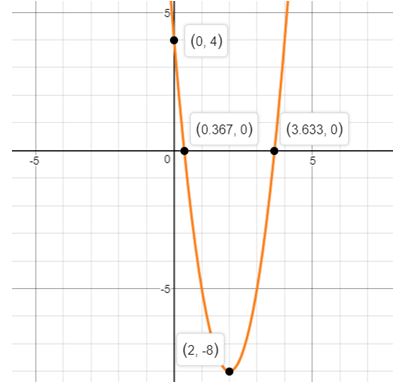
In Problems 4 and 5,
a. Determine whether the graph opens up or down.
b. Determine the vertex of the graph of the quadratic function.
c. Determine the axis of symmetry of the graph of the quadratic function.
d. Determine the intercepts of the graph of the quadratic function.
e. Use the information in parts (a)-(d) to graph the quadratic function.
f. Based on the graph, determine the domain and the range of the quadratic function.
g. Based on the graph, determine where the function is increasing and where it is decreasing.
To calculate:
a. Whether the graph opens upwards or downwards?
b. Determine the vertex of the function.
c. Determine the axis of symmetry.
d. Determine the intercepts of the graph of the given function.
e. Graph the given function.
f. Determine the domain and range of the function.
g. Determine where the function is increasing and where it is decreasing.
Answer to Problem 4CT
Solution:
a. The graph opens up as is positive.
b. The vertex is at .
c. The axis of symmetry is the vertical line .
d. The intercepts of the graph of the given function.
e. Graph of the given function is

f. The domain of the function is and range is .
g. The function is increasing in the interval and is decreasing in the interval .
Explanation of Solution
Given:
The given function is
Formula used:
Consider the function .
The vertex is at .
The axis of symmetry is the vertical line .
If , then the graph opens up and the vertex is the minimum point.
If , then the graph opens downwards and the vertex is the maximum point.
The is obtained by substituting in the given equation.
The is obtained by substituting in the given equation.
Calculation:
The given function is a quadratic function with .
a. The graph opens up as is positive.
b. The vertex is at
Thus, the vertex is at .
c. The axis of symmetry is the vertical line .
d. Determine the intercepts of the graph of the given function.
When , we get the as
Thus, the is at .
When , we get the as
e. Graph of the given function is

f. The domain of the function is and range is .
g. The function is increasing in the interval and is decreasing in the interval .
Chapter 3 Solutions
Precalculus Enhanced with Graphing Utilities
Additional Math Textbook Solutions
University Calculus: Early Transcendentals (4th Edition)
Elementary Statistics
Introductory Statistics
A First Course in Probability (10th Edition)
Thinking Mathematically (6th Edition)
- 3) If a is a positive number, what is the value of the following double integral? 2a Love Lv 2ay-y² .x2 + y2 dadyarrow_forward16. Solve each of the following equations for x. (a) 42x+1 = 64 (b) 27-3815 (c) 92. 27² = 3-1 (d) log x + log(x - 21) = 2 (e) 3 = 14 (f) 2x+1 = 51-2xarrow_forward11. Find the composition fog and gof for the following functions. 2 (a) f(x) = 2x+5, g(x) = x² 2 (b) f(x) = x²+x, g(x) = √√x 1 (c) f(x) = -1/2) 9 9(x) = х = - Xarrow_forward
- practice problem please help!arrow_forward13. A restaurant will serve a banquet at a cost of $20 per person for the first 50 people and $15 for person for each additional person. (a) Find a function C giving the cost of the banquet depending on the number of people p attending. (b) How many people can attend the banquet for $2000?arrow_forwardAlt Fn Ctrl 12. Find functions f and g such that h(x) = (fog)(x). (a) h(x) = (x² + 2)² x+1 (b) h(x) = 5 3arrow_forward
 Calculus: Early TranscendentalsCalculusISBN:9781285741550Author:James StewartPublisher:Cengage Learning
Calculus: Early TranscendentalsCalculusISBN:9781285741550Author:James StewartPublisher:Cengage Learning Thomas' Calculus (14th Edition)CalculusISBN:9780134438986Author:Joel R. Hass, Christopher E. Heil, Maurice D. WeirPublisher:PEARSON
Thomas' Calculus (14th Edition)CalculusISBN:9780134438986Author:Joel R. Hass, Christopher E. Heil, Maurice D. WeirPublisher:PEARSON Calculus: Early Transcendentals (3rd Edition)CalculusISBN:9780134763644Author:William L. Briggs, Lyle Cochran, Bernard Gillett, Eric SchulzPublisher:PEARSON
Calculus: Early Transcendentals (3rd Edition)CalculusISBN:9780134763644Author:William L. Briggs, Lyle Cochran, Bernard Gillett, Eric SchulzPublisher:PEARSON Calculus: Early TranscendentalsCalculusISBN:9781319050740Author:Jon Rogawski, Colin Adams, Robert FranzosaPublisher:W. H. Freeman
Calculus: Early TranscendentalsCalculusISBN:9781319050740Author:Jon Rogawski, Colin Adams, Robert FranzosaPublisher:W. H. Freeman
 Calculus: Early Transcendental FunctionsCalculusISBN:9781337552516Author:Ron Larson, Bruce H. EdwardsPublisher:Cengage Learning
Calculus: Early Transcendental FunctionsCalculusISBN:9781337552516Author:Ron Larson, Bruce H. EdwardsPublisher:Cengage Learning





